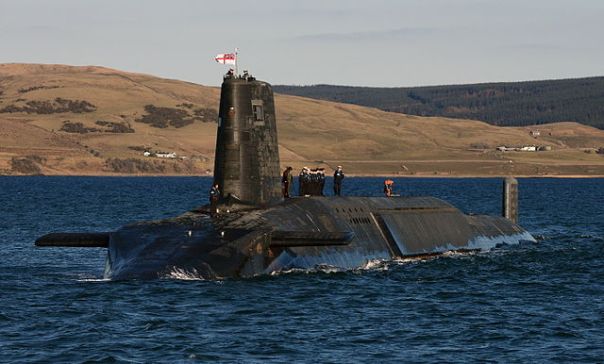Why the arguments that promote it just don’t work
By Linda Pentz Gunter
In trying to argue the myth of deterrence, it is easy to feel as if one has landed in the middle of this brilliantly inspired January 9, 1986 segment of the British television comedy, Yes, Prime Minister. In it, Sir Humphrey tries to persuade the British Prime Minister that purchasing Trident missiles will provide Britain with a nuclear deterrent. But the argument quickly unravels.
But many a truth spoken in jest, as they say. The uncertainty over what the enemy probably does or does not believe is at the very heart of why deterrence remains deeply flawed and arguably a myth.
Nevertheless, deterrence is the cornerstone of nuclear weapons policy, perpetuating their possession by nine nations. If we are serious about moving the nuclear ban agenda forward, we cannot shy away from the deterrence argument.
In our new Deterrence pamphlet, we set out ten reasons why nuclear deterrence cannot possibly work. We conclude that the only way to be 100% certain of nuclear deterrence is not to have any nuclear weapons at all.
Doubtless, the debate will continue. Deterrence hawks are not to be, well, deterred. And deterrence — given that it cannot actually work — isn’t even necessarily the real agenda.
The concept of deterrence is that the possession of nuclear weapons by one country would deter another nuclear weapons country — or even non-nuclear weapons country — from attacking. This has led to countries justifying their production of nuclear weapons as a national security measure while claiming they would only be used if already attacked by another nuclear country.
On closer examination, this thinking quickly becomes convoluted and illogical. And in reality there are more realpolitik reasons for having nuclear weapons — to offset conventional imbalance, prevent regime change, retain a seat on the UN Security Council, and so forth.
Nevertheless, deterrence is at the heart of defense policy and the justification for massive military spending among all the major super powers. An estimated $100 billion is spent globally each year on nuclear weapons. This amount could solve most, if not all, the problems — including climate change, famine, poverty and disease — that cause transboundary conflicts in the first place.

Trident nuclear submarine in Scotland (but not available in nuclear missile showrooms).
The central argument is the first one we address in the deterrence pamphlet, which posits each false premise, then provides a reality check. That first premise is that if we have nuclear weapons, this will deter other nuclear weapons countries from attacking us.
To buy into this argument for deterrence, each country would have to be 100% certain that the other would use their nuclear weapons, even if that would invite their own destruction. If certainty is not believable, then deterrence loses credibility. And if a nuclear country believes that its opponent would use nuclear weapons, it might use its own first, to knock out the enemy before he knocked out them. Plus, a nuclear weapons-armed foe under nuclear attack would likely use their own in retaliation. Then, instead, of deterrence, the result is “mutually assured destruction,” the worst possible outcome. Of course, if countries already agree that they need nuclear weapons to deter each other, then they can just as effectively disarm.
But deterrence proponents want it both ways. They also argue that deterrence works because no country would use nuclear weapons given the consequences are so horrible. This requires turning the first justification on its head. To buy into deterrence this time, an opposing country would have to be 100% certain its enemy would not use nuclear weapons. And if you know with 100% certainty that your enemy will never use nuclear weapons, then it is neither a weapon nor a deterrent. Finally, there would have to be 100% certainty that the chances of failure of deterrence are zero, since even a one percent chance of failure could have catastrophic consequences.
All of this begs the question that if a weapon is too horrible ever to use, is it even a weapon? If it is militarily useful only if you don’t use it, then it is fundamentally useless.
The need for a “credible” deterrent is the current justification for “upgrading” the US nuclear arsenal — code for making new nuclear weapons. But why do we need so many? If nuclear weapons deter, are 2,000 more “credible” than 10? Do we need to show we could destroy the world 100 times over to sound more “credible?”
This February I spent three days at the Nuclear Deterrence Summit. The rhetoric inside that Ritz Carlton ballroom (yes, the nuclear priesthood doesn’t slum it) was eerily reminiscent of the Cold War. Once again, it’s all about the “missile gap” and not letting the Russians “get ahead.” One representative even suggested that the world would be safest if the US was the only country with nuclear weapons. And maybe Britain, he added, detecting my accent.
“Why would Britain need nuclear weapons in that situation?” I asked.
“Well, er, they wouldn’t,” he replied.
We were back in Yes, Prime Minister.
Please read, download and distribute the Deterrence pamphlet. And see the work on deterrence by Rob van Riet of the World Future Council; Timmon Wallis of Nuclear Ban, US; and Ward Wilson of British American Security Information Council.
 Beyond Nuclear International
Beyond Nuclear International
Pingback: Forget deterrence | Beyond Nuclear International
Pingback: US could use canceled MOX plutonium fuel plant to make new nuclear weapons « nuclear-news
Pingback: MOX got nixed. Now it could be the pits | Beyond Nuclear International
Pingback: ??? What is wanted? | transformnowplowshres